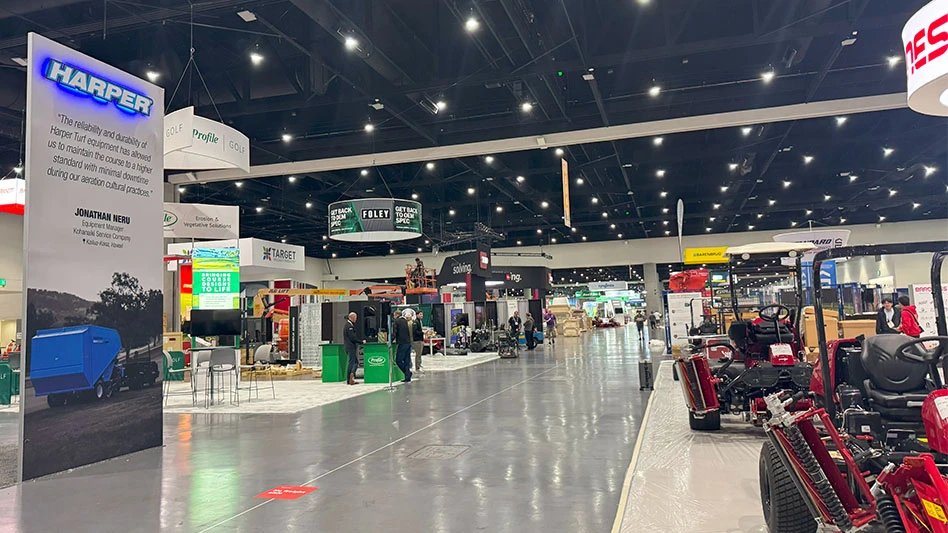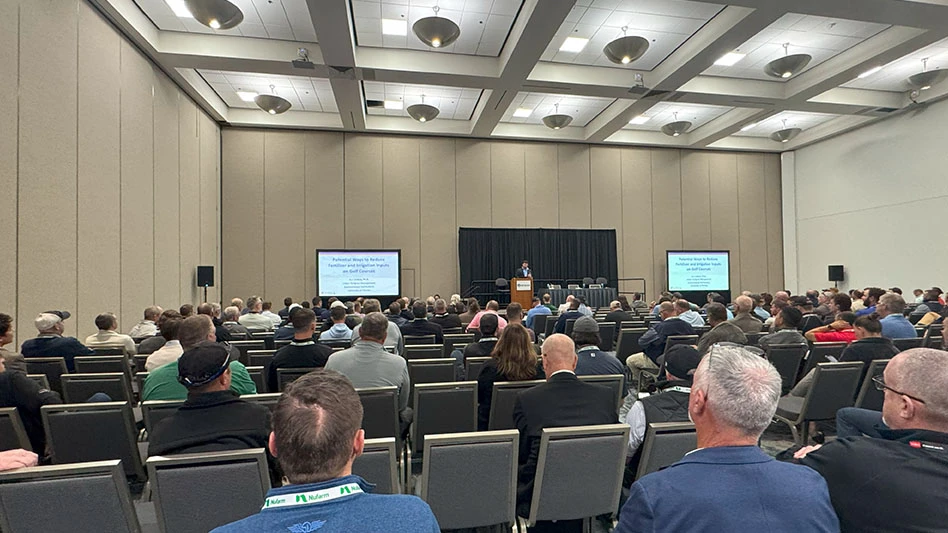
The summer is a difficult time for golf course superintendents who often find themselves managing turf under maximum stress from extreme heat and humidity increased amounts of play or, perhaps, disease. But turf managers can take steps to minimize the impact of stress while stimulating the plant’s own defense mechanisms.
The wet weather the Northeast experienced for much of what passed for spring put the region’s superintendents on alert, says Dr. Michael Agnew, a Syngenta technical manager. “To me that is a precursor to bad things happening later,” he says. “Because if the soil has been saturated, and the roots are unable to develop properly because there is no oxygen in the roots, that could set up for some pretty severe injury due to environmental stresses.”
Many in the Northeast and Mid-Atlantic, including the Transition Zone, are tending to Poa annua. There are certain signs a superintendent can look for that indicate their Poa is under stress, Agnew says. “If they start to see yellowing of the leaf tissue,” he says. “If they’re seeing unwarranted thinning, those are symptoms that are indicative of heat stress.”
Excessive heat and humidity makes turf more vulnerable to disease pressures, as well. “Diseases like summer patch and anthracnose, those two in particular, are biproducts of stresses,” Agnew says. “They are more prevalent when you have stresses occurring on the turfgrass. Summer patch, for example, will be more prevalent if you have a really wet spring during the period of time when the disease is starting to manifest itself in the soil.
“When you get into the heat of the summer, you’ll see (turf) dying a lot quicker because the plant has been set up for the progression of that particular disease. And with anthracnose, it’s the same thing if you have a really wet spring and a wet June and you’re not keeping the fungicides on it. It’s hard to grow annual bluegrass when the roots are already compromised before the heat of the season.”
Warm-season grasses, with the exception of Bahiagrass, are also vulnerable to stress issues, says Dr. Raymond Snyder, Harrell’s research and development manager. “Warm-season turf is most susceptible in moist, hot and cool weather, especially when light is low as a result of repeated cloud-cover,” he adds. “Warm-season turf is also very susceptible as a result of nematode pressure.”
Snyder explains that stress from heat, disease or some other cause will trigger the plant’s hypersensitive defenses. “Temperature, heat, pathogens and UV light are among several of the triggers that elicit plant defenses against stress,” he says. “Turf managers can prime the plant defense mechanisms using biostimulants, fungicides and proper nutrients prior to and during stress.”
Snyder stresses that one key to minimizing stress issues is providing turf with a solid nutritional foundation. “Avoid ‘lean’ practices,” he says. “Utilize products with known plant health benefits such as seaweed extract, fulvic acid, organic extracts, amino acids and fungicides.”
Joel Simmons is the President of EarthWorks Natural Organic Products and a proponent of biological soil management, the practice of stimulating microbial activity in the soil which in turn enhances the health of the turf and improve its resistance to disease and other sources of stress. “That’s the foundation of all plant health, specifically turf health,” he says. “If we can get the soil equation to play a part in this, the inherent resilience of those plants are going to be significantly stronger. Biological soil management basically directs us to look at the overall health of the soil starting with soil chemistry, so the soil opens up physically.”
Simmons cites the so-called “three-legged stool,” striking a balance between chemistry, physics and biology within the soil. “That’s what biological soil management directs,” he says, “And it focuses its attention primarily on the biological leg.
“But you can’t focus on biology unless you’ve got soil chemistry working which means starting with a good quality soil test, getting the core chemistries correct, like calcium, magnesium and potassium ratios, and keeping sodium and bicarbonates at bay by managing them appropriately. As you get chemistry correct, you will also have the soil opening up physically which means more water and air will move through, soil will drain better … and what all of that does is create a better environment for the proliferation of soil biology.”
The soil biology Simmons refers to is essentially bacteria. “Research shows that turf soils are predominately dominated by very simple biological life – in a word, bacteria,” he says. “The same research shows the bacteria need ample amounts of highly available and predigested carbon sources like composts, simple sugars, fish and kelp meal so they can quickly reproduce to do their job of digesting roots. When there is available carbon in the soil, microbes proliferate, releasing ammonium nitrogen and producing even levels of fertility.”
Simmons notes superintendents should have a fertility program that integrates the soil and turf, as opposed to regarding them as separate entities.
“It really is a situation where we have to work both soil and the plant together,” he says. “Not one at the exclusion of the other. And not forgetting that soil piece is imperative. It’s a little bit more challenging. But when you’ve got the soil working for you and you’ve got a carbon-based fertility program that feeds microbial populations, which is what carbon-based fertility is about, and is the foundation of BSM, that’s going to start to take away the highs and lows of all fertility so you don’t have these peaks and valleys. You don’t walk in one day and find out, ‘Oh my gosh, there’s no food left in the pantry.’ What this does is assure the survivability of that plant material over a long sustainable period.”

Explore the July 2018 Issue
Check out more from this issue and find your next story to read.
Latest from Golf Course Industry
- Beyond the Page 64: To infinity and beyond
- Plant Fitness expands into Asia Pacific markets
- Ace of a decision
- Idaho course joins Concert Golf portfolio
- Central Turf & Irrigation Supply celebrates 35 years in the industry
- Musser Turfgrass Foundation honors University of Georgia researcher
- Riviera CC donates $1 million for fire relief
- Bernhard and Company names North American Distributor of the Year





